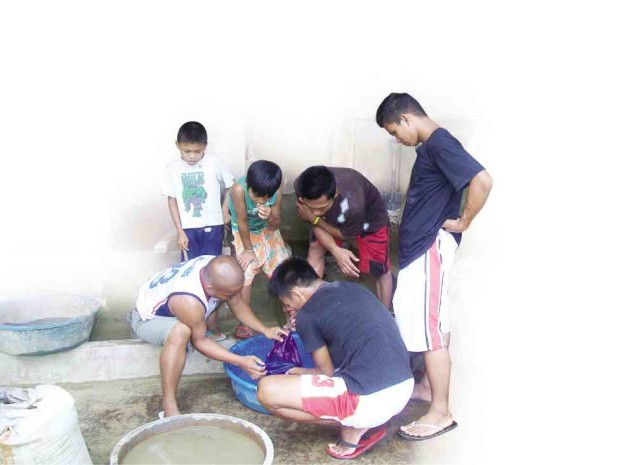In Compostela, ‘green’ mining beckons

MINERS in Monkayo, Compostela Valley province, extract gold using mercury in this photo taken on Oct. 25, 2013. They will be among the beneficiaries of a new, less toxic method of extracting gold. FRINSTON LIM
SMALL-SCALE miners in Compostela Valley province have welcomed the introduction of a clean and efficient way of processing gold as an alternative to decades-old crude and toxic methods of extracting precious metals that have been blamed for pollution and other environment problems.
The “green mining technology” being developed by government scientists and experts is being tested in Compostela Valley, the fourth beneficiary across the country after Benguet, Camarines Sur and Agusan del Norte. The four pilot projects in the gold-rich provinces cost about P160 million.
Jose Anayo Jr., manager of Nabunturan Integrated Mining Development Cooperative (NIMDC), said his group was pinning high hopes on the project’s viability.
Funded by the Philippine Council for Industry, Energy and Emerging Technology Research and Development of the Department of Science and Technology (DOST), the project aims to “validate the viability and commercial application of enhanced procedural mineral extraction without the use of harmful chemicals such as mercury and cyanide.”
Natural ways
The processing plant will function by flotation and gravitation—natural ways of extracting gold without the use of hazardous chemicals, said Dr. Rowena Cristina Guevara, DOST undersecretary for scientific and technological services.
“When you use mercury or cyanide, you only extract 40- to 60-percent gold. With this technology, the extracted gold is at least 90 percent, so miners can earn twice as much,” Guevara said.
Dr. Herman Mendoza, program leader from the University of the Philippines, said the plant would use an old technology still being used by responsible miners in many parts of the world. He explained that the integrated gold-processing plant was environment-friendly as long as miners would operate it properly.
Flotation works by applying a small amount of an organic chemical called a “flotation reagent” on processed gold ore to coat small gold particles into bubble-like compounds so the precious metal can float above a mixture and be extracted.
The facility is efficient that “even mine tailings and other mine wastes will be managed properly,” Mendoza said.
Local gov’t help
According to Guevara, the project will be implemented with help from local government units (LGUs) in Nabunturan and the provincial capitol, and a local mining cooperative.
The Philippines has a huge potential in the mining industry, ranking third in the world with known gold reserves estimated at 5.02 billion tons in 2011.
Small-scale mining, which employs more than 300,000 people in 30 provinces, accounts for 80 percent of the total mining workforce. In 2014 alone, the Mines and Geosciences Bureau estimated that the small-scale mining industry accounted for P32.9 billion of the nation’s gross domestic product.
The introduction and subsequent use by most small-scale miners of the UP-DOST integrated gold-copper mineral processing plant can stimulate robust economic growth and make the local mining industry more competitive with the inroads in the Association of Southeast Asian Nations (Asean) economic integration, Guevara said.
Best type of cooperator
Mendoza said the concept worked wherein the government, particularly the DOST, bankrolled the building of a pilot plant and spread the technology, encouraging miners in other areas to build their own as well.
“We want to know the best type of cooperator so we decided to have a mining cooperative as partner in Compostela Valley,” he said. The Benguet project is being run by a mining federation, while the Agusan del Norte project is under the LGU, and in Camarines Norte, a private mining firm.
Anayo acknowledged that small-scale mining in Compostela Valley had never been that clean.
“Destruction of the environment and pollution have been the effects of small-scale mining. From polluting rivers and streams to destroying mountains and using chemicals to extract gold, but we miners have no choice,” he said.
“With this new technology, we hope it can make small-scale mining environment-friendly and help boost our mineral production and increase economical benefit,” Anayo said.
The P40-million gold-copper mineral processing pilot plant is set to rise in Katipunan village in Nabunturan. It started in September last year.
Once the processing plant has been set up, field testing can begin and may last up to three months.
Pilot area
Compostela Valley was chosen as pilot area owing to its huge small-scale mining industry, with nine out of its 11 municipalities hosting gold-rich sites.
Undersecretary Guevara said Jonathan Sales, the DOST regional chief, has also recommended the inclusion of Compostela Valley in an effort to help the small-scale mining sector recover following the devastation wrought by Typhoon “Pablo” in 2012.
NIMDC, a collective of 66 small-scale mining operators in the gold-rich villages of Nabunturan such as Tagnocon and Bukal, would provide the
5 to 15 metric tons of ore a day needed in the field testing.
With the technology, Mendoza said, they hope to bring down the processing costs and maximize miners’ profit. He said the technology could mean minimal cost and lower minimal quantity of 5 tons, allowing miners to wring cash out of their day gold ore.
The government is also looking at expanding the number of pilot areas to 10 throughout the country. “Our vision is to see to it that everything in the plant is locally fabricated. We will teach the miners themselves how to run the facility and do it 100 percent,” Mendoza said.
Nabunturan miners pay at least P60,000 to process some 20 tons of ore (about 400 bags of 50-kilogram ore) in carbon-in-pulp plants, which use cyanide and mercury. The UP-DOST technology can help lower or eliminate that cost, Anayo said.
“That’s already a huge amount of money going straight to the miners,” he said.














